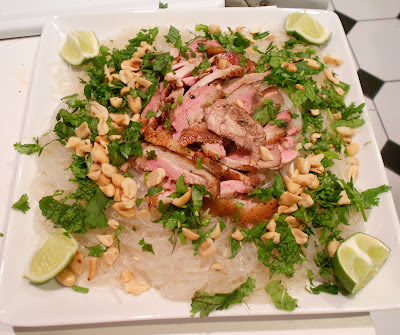 | |
| Duck Ragu |
I like my knives, without them I wouldn’t have much use for
a whole duck. If I just bought the
breasts and I’d get one dinner for a couple people. Throw in the legs and I might have confit or
the base for a rich ragu. Give me the
whole bird and I have visions of days of meals to come- seared duck breasts one
night, molten braised legs another, fat trimmings rendered and reserved for
roasted potatoes, and the flavor packed carcass just waiting to form the base
of my next poultry stock.
Back home with the duck, out came the knives and off came
the breasts. Seared to
a perfect medium rare I wasn’t interested in serving the breasts plain. Instead, I sliced them paper thin and placed
the duck on a bed of Vietnamese rice noodles with roasted peanuts, cilantro,
lime, and mint with a sauce of tamarind, chilies, and fish sauce.
 |
| Duck Breast with Vietnamese Vermicelli Salad |
Next I went to work on the fat. I cut as much of the skin and attached thick
layer of fat as I could off the carcass and put in in a pot over medium low
heat. After about 30 minutes with barely
any attention paid, the fat had melted away.
I strained that off and added to the reserved drippings from the duck breasts. Purple potatoes were cubed and roasted with a
healthy dose of the melted fat. The rest
went in a jar and into the refrigerator to be used in weeks to come.
Several days later it was time for the legs. Onion, garlic, carrot
and celery went in the clay pot with some fresh rosemary and a couple of bay leaves. Reduced red wine, diced canned tomatoes,
chicken stock, and the legs rounded out the sauce. A couple of hours later I pulled the once tough now achingly tender meat off the bone and mixed it back into the
pot. Tossed with freshly cooked pasta it
was a meal fit for a king, or at least four hungry adults.
As for the carcass, it is in the freezer in a large bag
marked “duck bones” waiting to be defrosted some lazy Saturday when I feel like
putting a pot on to simmer.
One week. One
duck. Many meals had and more still to
come. I might finish the old-timer’s
sentence for him: Beware a woman with
sharp knives, a whole duck is no match for her in the kitchen.
Duck Ragu
Time: 2 hours
Yield: 4 servings
2 T. olive oil
1 medium onion
1 carrot
2 celery stalks
3 garlic cloves
2 T. minced rosemary
leaves
2 bay leaves
1 cup red wine
2 duck legs
Salt
Pepper
2 cups diced canned
tomatoes
1 cup chicken stock
1 lb. linguine
Parmesan cheese
Heat oil in a heavy
pot over a medium flame. Dice onion,
peel and dice carrot, and dice celery.
Add the vegetables to the pot.
Saute for about ten minutes until softened. Crush garlic and add to vegetables along with
rosemary and bay leaves. Saute for
another two minutes. Add wine and bring
to a simmer. Reduce wine by half. Meanwhile season duck legs with salt and
pepper. Add tomatoes, duck legs, and
chicken stock to the pot. Bring to a
simmer then reduce heat to medium low.
Put a lid on the pot and let simmer for 1.5 hours stirring occasionally,
until duck meat is tender enough to fall off the bone. Remove duck legs from the sauce. Remove skin and any visible fat and
discard. Remove meat from bones and shred. Before adding the meat back to the sauce use
a small ladle to skim off any fat that has pooled on the surface. Stir the meat back into the sauce and season
with salt and pepper to taste. Discard
bay leaves. Bring a large pot of salted
water to a boil and cook the pasta until just shy of al dente. Add the pasta to the sauce with a bit of the
pasta water. Let pasta finish cooking in
the sauce. Serve with grated parmesan
cheese.
Amy Powell is a food and travel writer based in New York City. She is a graduate of Cornell University's School of Hotel Administration and the French Culinary Institute. Follow her on Twitter @amymariepowell

No comments:
Post a Comment